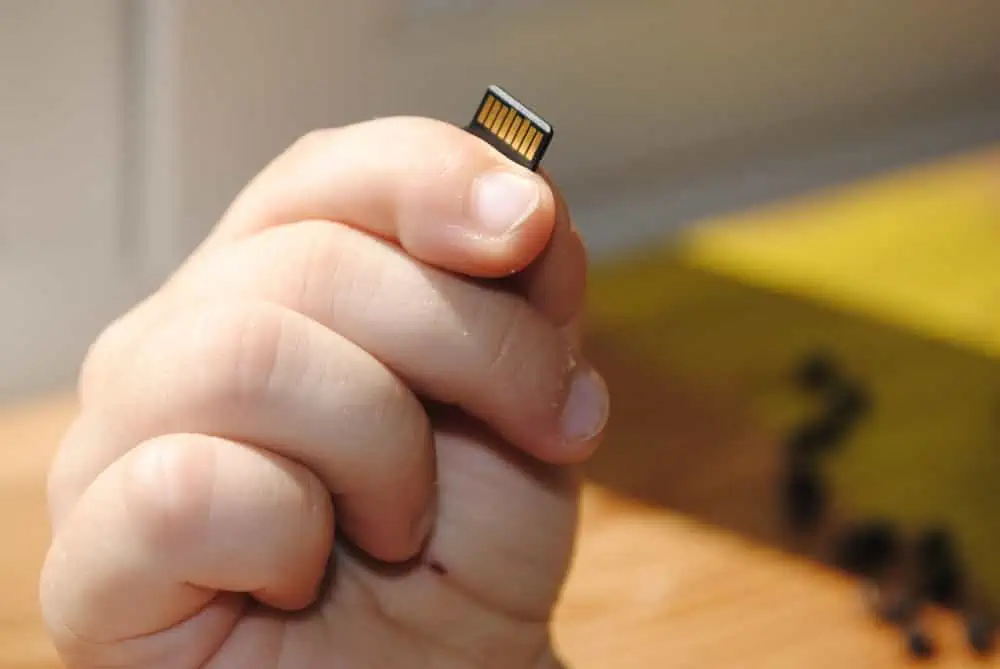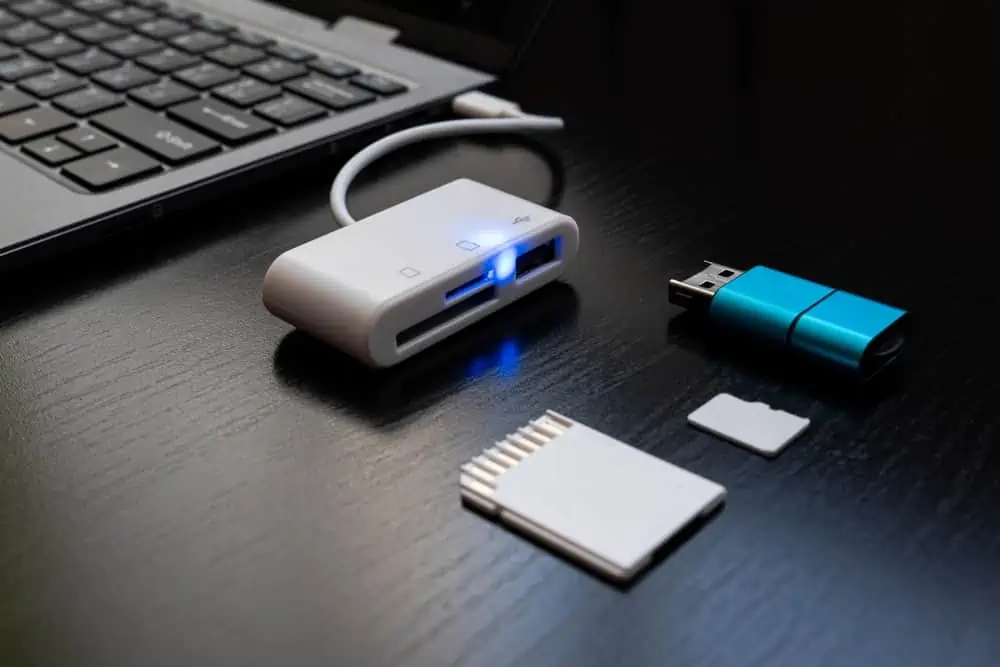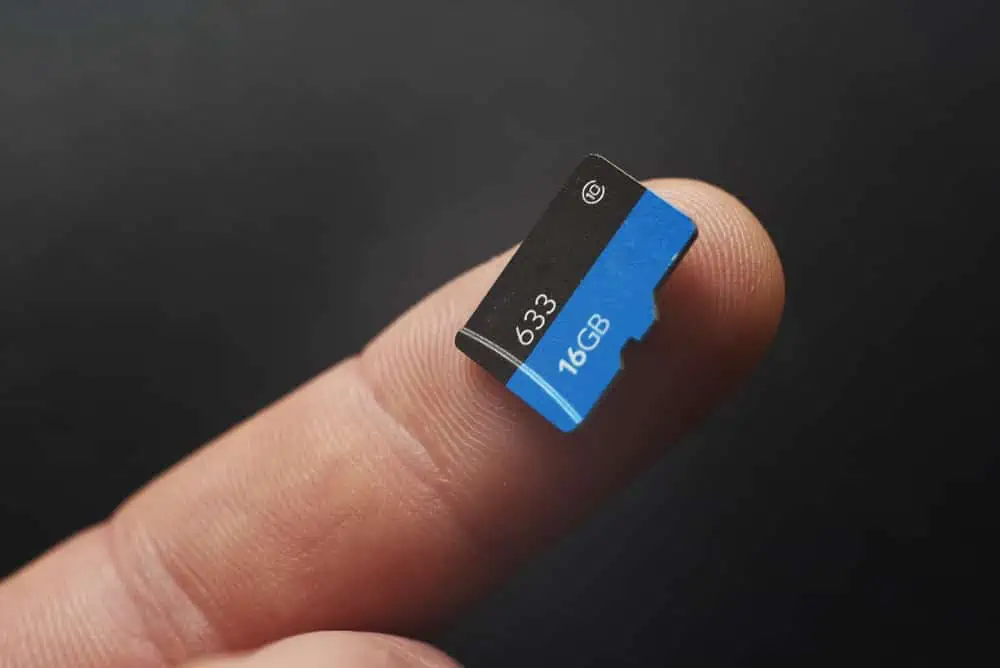Are laptops with eMMC storage better than ones with SSD? Get all the information you need about these two storage technologies from this eMMC vs SSD explained article.
Overview
Embedded Multi-Media Card (eMMC) is a solid storage device. In addition to being solid, it is embedded (soldered) on the circuit board of its host device.
By being “solid”, I mean that this type of storage has no moving parts.
In other words, eMMC is a kind of memory card that is non-removable from the host device. This is why eMMC usually serves as inbuilt storage on phones, tablets, and some laptops.
Moreover, this storage uses the same NAND flash memory that USB drives, SD cards, and SSDs use. So, it doesn’t require power to retain its data.
By having NAND flash memory, you can tell that an eMMC will be very fast in operation. Moreover, it is clear that you can not upgrade such storage since it is permanently soldered to a motherboard.
Nevertheless, devices with eMMC usually have a storage expansion slot for SD cards.
Coming to Solid State Drive (SSD), this too has no moving parts. However, it is not soldered onto the motherboard of its host device.
Instead, it is attached to the motherboard with a ribbon cable. Usually, this ribbon cable plugs into the SSD and into the motherboard via a SATA, mSATA, or PCIe interface.
In terms of NAND gates, unlike eMMC, SSD has several NAND flash chips up to 15 or 20 chips on a single board.
Regarding these NAND chips (ICs), each one has the same flash memory as eMMC. With these ICs, an SSD will perform very fast, even faster than eMMC.
Also, the interface with which SSD is attached to a circuit board allows for its removal and reconnection. This makes it upgradeable, unlike the eMMC.
How They Work Compared
An embedded MultiMedia Card has its flash memory and a memory controller on a single IC chip. This memory controller permits a phone or tablet to read the memory of an eMMC embedded in it.
Moreover, the memory controller formats the eMMC’s memory into a structure that the host device understands.
So, when the host device needs access to the memory, it sends an electrical signal to the eMMC. Speaking of the signal, it is a special voltage sent through one of the pins (legs) of the storage chip.
Impressively, this signal travels fast, and the NAND flash memory on the eMMC responds quickly to it. The response can either be writing (saving) data into the memory or removing (deleting) existing data.
Therefore, you can see tablets and smartphones with this storage opening files at 223.1 MB/s. Also, such devices can save files at up to 138.2 MB/s.
Coming to SSD, as I mentioned in the last section, this has several NAND IC chips and memory controllers too. However, an SSD’s memory controller is equipped with firmware that gives it better performance.
Since an SSD has several memory chips, its memory controller distributes operations to all the chips. For instance, if an SSD has 15 NAND chips, its read/write operations will be shared evenly among the 15 chips.
Consequently, the speed of an SSD does not dependent on one memory chip. This makes SSD storage drives super-fast in opening and saving files.
Perhaps, it won’t surprise you when you see a laptop with an SSD opening files at a speed of 1069.5 MB/s. This speed is far above that of an eMMC.
However, saving files is usually at an equal rate to an eMMC (about 130.1 MB/s).
Features Compared
I gave a quick overview of eMMC vs SSD in the preceding sections. I have also compared how the two storage technologies work.
In the following sub-sections, I will compare the main features of eMMC vs SSD. So, here we go…
You Can Upgrade an SSD but You Cannot Upgrade eMMC Storage
I mentioned earlier that eMMC is embedded or soldered directly to a device’s motherboard. This affects its upgradability.
For instance, to desolder an eMMC chip, you’ll turn your circuit board upside-down, and heat the chip area. However, this increases the chances of damaging the chip from high temperatures.
As a result of this, it is very difficult, if not impossible to replace or upgrade it.
As for SSD storage, the case is different. It is plugged into its host device with a ribbon cable.
Precisely, the type of plugging slot it uses includes PCIe, SATA, and mSATA interfaces. Appreciably, these interfaces make it very easy to upgrade an SSD storage.
Thus, instead of using heat as it is with eMMC, one can easily unplug and replug an SSD at any time.
SSD are Faster Than eMMC Storage Drives
Embedded MultiMedia Cards are similar to SD cards, and hence, are much slower than SSD.
Moreover, eMMC devices also have a controller that makes the eMMC bootable. So, it’s also used as a system drive inside cheap Android phones, Chromebooks, tablets, and laptops.
However, what eMMC lacks is the firmware and multiple flash memory chips that makes an SSD so fast. So, booting a device with it will be fast, but not as fast as a device with an SSD.
Don’t forget though, that all eMMC storage does not perform equally. As a matter of fact, some of them are faster than others.
On the other hand, an SSD has more than enough components that make it the fastest in operation. So, its host device can boot at a speed faster than devices with any other boot drive.
Speaking of the components, it has multiple NAND chips that share each task among themselves. Also, it has firmware that distributes tasks among the chips.
In addition to that, an SSD uses faster connection interfaces than eMMC’s interface.
Noise, Vibration, and Power Consumption
An eMMC storage is solid, hence, it has no moving parts such as spinning disks. Therefore, while it is running, it does not make any noise nor vibrate the device.
Hence, smartphones, tablets, and laptops that use this storage type operate quietly.
Regarding power consumption, eMMC consumes less power than SSD. Though, the difference in their power consumption may be insignificant and arguable at times.
On average, eMMC consumes as little as 0.5 to 2 Watts. One benefit of this low power consumption is that eMMC improves the battery life of its host devices.
Similar to eMMC, SSD storage is solid and has no spinning disks as well. So, a laptop that uses it makes no noise nor vibrates while running.
Concerning power efficiency, SSD may consume a little more power than eMMC. However, its power consumption is less than that of a Hard Disk Drive.
On average, SSD can consume about 2 to 3 Watts.
Roughly Equal Average Transfer Speed of Up to 400MB/s
Newer versions of the eMMC standards continue to come out in different specifications. The latest version (as of October 2021, when I published this article) was version 5.1A.
Specifically, this version opens files (sequential read) at a speed of 250MB/s. Also, it saves files (sequential write) at the rate of 125MB/s.
eMMC version 5.1A offers a typical transfer rate of up to 400 megabytes per second (MBps). In comparison, a solid-state drive using a SATA connection offers about the same transfer speed.
One more thing – note that eMMC is faster in transferring fewer files while SSD is faster in transferring huge files.
So, if you consider the low cost of eMMC, getting a storage transfer speed comparable to an SSD is not bad.
Price/cost of the Storage
The final comparison of eMMC vs SSD is their prices. Devices (phones, tablets, or computers) that ship with eMMC are much cheaper than those that ship with SSD drives.
However, SSD drives compensate for the price difference with their much faster performance.
Pros of eMMC vs SSD
Fast Read and Write Speed
Both eMMC 5.1 and SATA SSDs can achieve a transfer speed of up to 400MB/s. Moreover, these devices can achieve very high writing speed.
If you’re wondering what Read and Write speed means, a read occurs when you open a file on your device. On the other hand, a write operation happens when you save a file.
So, since eMMC and SDD offer fast read/write speeds, devices using them will perform better than those with HDDs. This is assuming that all other factors are equal.
eMMC and SDD are Both Noiseless
Have you ever worked on a laptop and heard a spinning noise? This noise is typically caused by spinning HDD platters or CPU fans.
On the contrary, have you ever heard such annoying noise on your smartphone or tablet? The answer is No!
You will not hear such noise on your smartphone because your smartphone likely uses an eMMC storage. Also, you will not hear such noise from a laptop that uses SSD storage, except for the novice coming from the fan!
This is a major advantage.
eMMC and SSD are Highly Power-efficient
An SSD storage is power-efficient while eMMC is more power-efficient. Hence, the battery on your tablet or smartphone with eMMC storage can last for 3 to 5 days per charge.
Meanwhile, that is not the case with laptops having SSD storage if we disregard battery configurations and other factors. Such laptops’ battery life usually lasts a few hours per charge.
Nevertheless, devices with either of these two storage types have longer battery life than ones with HDD. This is because HDDs have mechanical parts (spinning disks) that consume more power.
Higher Portability of eMMC and SSD Storage
eMMC is very small, making them suitable for mobile devices. You’ll find eMMC flash memory in smartphones, tablets, and low-cost ultraportable laptops.
In comparison, SSDs are bigger in size than eMMC. Nevertheless, SSDs are pretty thin compared to HDDs.
Because of their thinness, SSDs are used on slim and lightweight computers where HDDs can’t fit in. For example, you’ll find SSDs in ultra-slim notebooks, subnotebooks, and other powerful and portable laptops.
Automatic Handling of Data Read and Write Operations
The fact that eMMC storage has a built-in controller that manages data read/write operations is another advantage. This is because it frees up the CPU to perform other tasks.
Since the CPU does not handle read and write operations, it is free to perform other tasks.
This means that the device’s overall performance – smartphone, laptop, or tablet – will be faster.
In the same fashion, I have mentioned earlier that an SSD has firmware that distributes tasks to its NAND chips.
So, if an SSD has 20 NAND chips, this firmware shares each write operation among the 20 NANDs. As a result, the work is done faster than when single flash memory is in use
Cons of eMMC vs SSD
The Storage Capacity of eMMC and SSD is Low
The first drawback of the eMMC vs SSD comparison is that both offer a smaller amount of storage range.
For example, you can find eMMC storage in 32GB and 64GB. However, there are also 128GB and 265GB eMMC storage which are difficult to find.
On the other hand, SSDs come mostly in 256GB or 512GB sizes. Higher-capacity SSDs exist, but such ones may be too costly to buy.
The implication of this is that devices with these types of storage do not offer much storage space. Appreciably, most devices with eMMC and SSD come with storage expansion slots.
Therefore, if you get a device with eMMC or SSD storage, you’re likely to accept low storage. Meanwhile, you can get HDDs with a terabyte of storage space at a fairly affordable price.
eMMC is Not Upgradable, Unlike SSD
In terms of upgradeability, eMMC is very difficult to upgrade, if at all possible. More specifically, upgrading eMMC storage requires special technical skills in electronics soldering and desoldering.
Conversely, upgrading an SSD storage is less complicated. Even at that, it also requires some level of understanding of computer hardware maintenance.
A Limited Number of Reads/writes Before Failing
An SSD is expected to last for about ten years. For someone who bought a high-capacity SSD at a high price, ten years’ lifespan is agreeably short.
Coming to eMMC, the lifespan should be shorter than that of SSD. This is true since eMMC carries out all operations using only one NAND chip.
However, the lifespan is also affected by how often you delete and re-save new files on this storage.
Unlike SSD, eMMC is Not Designed to Run Demanding Applications
Devices with eMMC storage are incapable of running resource-heavy applications. So, they are best used in handling light computing tasks such as web browsing, media playing, and the like.
On the contrary, laptops with SSD storage do better in running demanding jobs. Hence, computers that are meant for gaming and content creation usually feature SSD storage.
eMMC and SSD Do Not Support Distributed Access
Only the device in which eMMC is soldered can use the storage at a time. Hence, multiple users can not access it concurrently.
The same thing applies to SSD storage. Its SATA or PCIe cable alone gives access to it. This implies that multiple users or devices can not access the contents of an SSD at a time.
Conclusion
From this guide, we have seen clearly that eMMC and SSD storage are better than traditional HDDs. We have also seen that SSDs are better than eMMC storage in many of the areas of comparison.
While both of them are noiseless storage types, the eMMC uses less power to operate.
If you want to buy a laptop, remember that those ones with SSD storage are faster in speed. Also, you’ll find it easier to upgrade an SSD storage on your laptop than eMMC.
Lastly, with smartphones and cameras, we know that we don’t get the option of SSD storage, but eMMC. However, if a laptop presents the two storage options to you, go for the SSD option.
I hope I was able to explain eMMC vs SSD and how they compare to each other. I also hope that you found the article easy to understand.
If you did, click on “Yes” beside the “Was this page helpful” question below. You may also express your thoughts and opinions by using the “Leave a Comment” form at the bottom of this page.
Finally, you may find other helpful articles on our Storage & Disk Technology Explained page.



